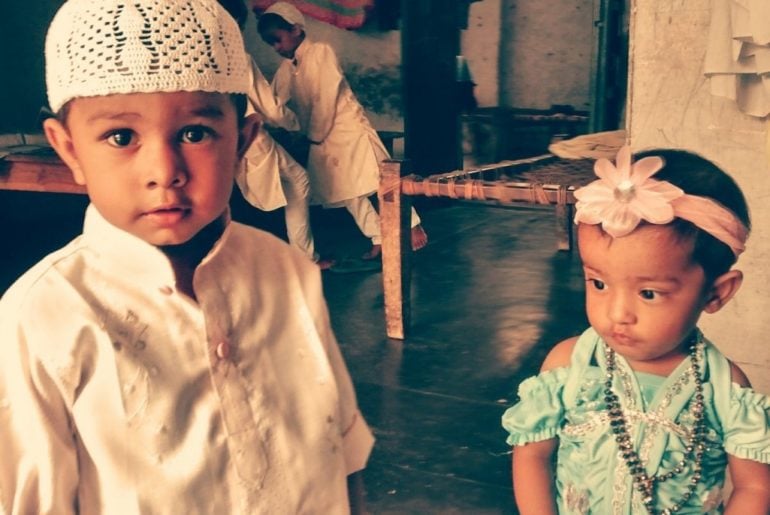Did you know a quarter of the world celebrates Ramadan? This major Muslim holiday is underway! Whether your kids have family, friends, or neighbors who celebrate, or you just want them to understand more about the world around them, there are plenty of reasons to teach kids about this holy month.
Here’s a script for explaining the month of Ramadan in a way that is clear, interesting, and fun for kids—so the whole family can be aware of what’s going on during this important time of year.
Why is Ramadan important?
You can tell your kids:
“Nearly 1 in 4 people in the world are Muslim, making Islam the second biggest religion. The five countries with the largest Muslim populations are Indonesia, India, Pakistan, Bangladesh, and Nigeria.”
“Ramadan, the ninth month of the Islamic calendar, is the holiest month for Muslims.”
To explain some of the basics of the religion plus just how important Ramadan is, show kids the Five Pillars of Islam:
- Shahada (declaration of faith)
- Salat (prayer)
- Zakat (giving alms/charity)
- Sawm (fasting during the month of Ramadan)
- Hajj (pilgrimage to Mecca)
What happens during Ramadan?
“Muslims fast during Ramadan, which means they usually don’t eat or drink anything from dawn until dusk for 30 days. The fast also includes moral goals, like no lying, gossip, or treating others badly.
“It’s also a time for Muslims to think about their relationship to God, how to become a better person, give to people in need, do good deeds, gather for extra prayers at nighttime, and spend time with family and friends.”
“Why is fasting a part of Ramadan? It brings people closer to God, strengthens their spirituality and faith, helps people work on their self-discipline, and reminds them to appreciate what they have.”
How does fasting work?
“Young kids, the elderly, travelers, people who are pregnant or breastfeeding, and sick people are not required to fast. Sometimes kids do a partial fast to try it out, like just cutting out snacks or only fasting on weekends.”
“Adults and teens who fast during Ramadan usually wake up early to have a meal before sunrise (called suhoor) and later enjoy an evening meal after sunset (called iftar).”
“If adults break their fast on any day during Ramadan, they can make up for it by fasting at another time of year. Or they can pay fidyah, which means giving money or food to someone who needs it.”
How does the fast end?
“After the last day of Ramadan, there’s a three-day festival called Eid al-Fitr (sometimes just called Eid) to celebrate and break the fast. There may be gatherings, gift giving, decorations, and of course lots of food.”
“It’s a time to have fun and indulge in things like dessert and candy. Actually, Eid is the only time during the Islamic calendar when fasting is not allowed!”
Is Ramadan similar to any other holidays?
“Ramadan is a special time of year that people of other religions and cultures can relate to.”
“The fasting part is similar to how Christians avoid certain foods or other habits during Lent, and to how Jews fast during some holidays such as Yom Kippur (the Day of Atonement). Hindus and Buddhists also fast at certain times.”
“Ramadan’s month-long focus on giving, gathering with friends and family, and reflecting on how to be a better person—ending with a celebratory feast and treats—has a lot in common with other holiday seasons including Thanksgiving, Christmas, New Year, and Kwanzaa.”
Fun facts about Ramadan
“Ramadan shifts 10-11 days earlier on the calendar each year, because it’s based on the Islamic lunar months, which follow the cycles of the moon. That means Ramadan can happen in any season! This year Ramadan is observed from February 28 through March 29.”
“In many cultures, Muslims break the fast each day—and at Eid al-Fitr feasts—by eating dates, the sweet and healthy fruit of the date palm tree.”
“In Indonesia, people plunge into the water of natural springs, lakes, and pools to clean their bodies and souls on the day before Ramadan.”
“In UAE, kids walk around their neighborhoods in brightly colored clothing and sing songs in exchange for candy and treats 15 days before the start of Ramadan.”
“One of the most popular desserts to have at Eid feasts in South and Central Asia is sheer kurma, a warm sweet milk made with dried fruits, vermicelli (thin noodles), cardamom, and saffron.”
Also check out these other holiday and cultural explainers for families:
- A fun script for explaining Hanukkah to kids
- A fun script for explaining Kwanzaa to kids
- A fun script for explaining Lunar New Year to kids
- A simple script for explaining Diwali to your kids
- Explaining parts of Arab American culture your child might see
- How to explain Labor Day to kids: A script for parents
This article was originally published on April 12, 2021.







